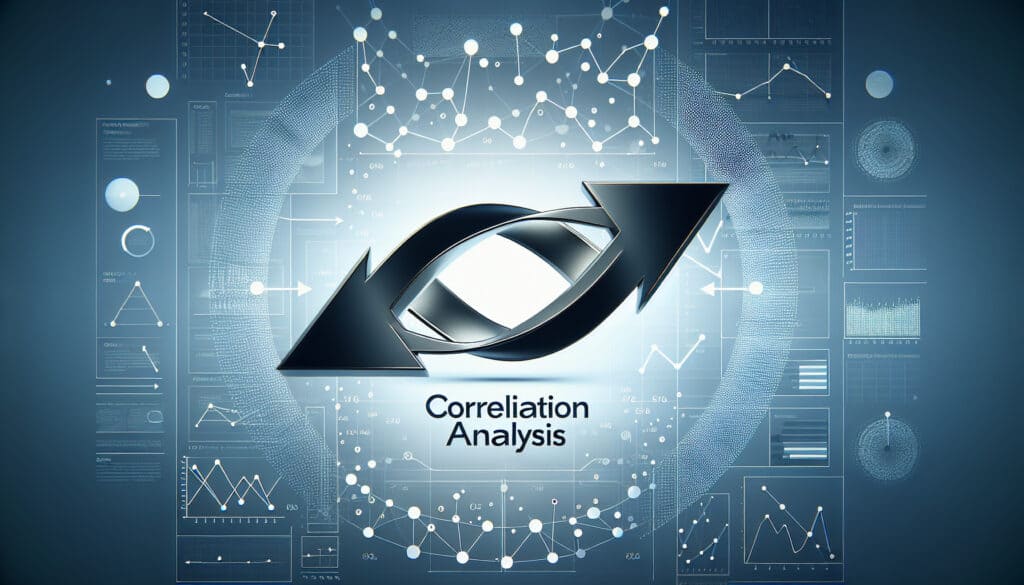A statistical Verfahren used to evaluate the strength and direction of the linear relationship between two quantitative variables.
- Methodologien: Maschinenbau, Ergonomie
Korrelationsanalyse

Korrelationsanalyse
- Kontinuierliche Verbesserung, Prozessverbesserung, Qualitätskontrolle, Qualitätsmanagement, Statistische Analyse, Statistische Prozesskontrolle (SPC), Statistische Tests
Zielsetzung:
Wie es verwendet wird:
- This technique is applied to a set of data points to determine if a change in one variable is associated with a change in another variable, represented by a correlation coefficient (r) from -1 to +1.
Vorteile
- Identifies potential relationships between variables, which can be a starting point for further investigation; provides a single number to summarize the strength of the association.
Nachteile
- Correlation does not imply causation; it only measures linear relationships and can miss more complex ones; it can be skewed by outliers.
Kategorien:
- Wirtschaft, Lean Sigma, Problemlösung, Qualität
Am besten geeignet für:
- Identifying the statistical relationship between two variables, for example, between production speed and the number of defects.
Correlation Analysis finds extensive application in various industries such as manufacturing, healthcare, finance, and marketing, where understanding relationships between variables can drive significant improvements. In the manufacturing sector, it can aid in monitoring quality control by correlating production speed with defect rates; this allows engineers to adjust workflows and reduce defects. In healthcare, researchers often use correlation to assess relationships between patient factors, such as lifestyle choices and health outcomes, guiding public health initiatives. Within the finance industry, analysts may examine the correlation between economic indicators and stock market performance, helping to refine investment strategies. The methodology is particularly useful during the data analysis phase of projects, where teams comprised of data analysts, engineers, and domain experts collaborate to interpret findings and formulate hypotheses. The initiation of such analyses typically stems from a need to understand underlying patterns in data, prompting teams to gather information from diverse sources and implement statistical tools to identify significant correlations. This approach fosters a data-driven culture within organizations by enabling stakeholders to make informed decisions based on empirical evidence, ultimately identifying opportunities for innovation and improvement across various contexts.
Die wichtigsten Schritte dieser Methodik
- Select the variables of interest for analysis.
- Calculate the correlation coefficient (r) using statistical software or tools.
- Interpret the correlation coefficient to determine the strength and direction of the relationship.
- Conduct hypothesis testing to assess the significance of the correlation.
- Examine the scatter plot to visually assess the relationship between the variables.
- Consider potential confounding factors that may influence the relationship.
- Investigate non-linear relationships if initial results suggest correlation.
- Document findings, including the correlation coefficient and significance levels.
Profi-Tipps
- Utilize advanced statistical software to validate correlation coefficients and mitigate risks associated with spurious correlations.
- Incorporate control variables into your analysis to isolate the effect of the primary independent variable on the dependent variable.
- Consider using a sliding window approach for time series data to observe how correlation changes over different time intervals.
Verschiedene Methoden lesen und vergleichen, Wir empfehlen die
> Umfassendes Methoden-Repository <
zusammen mit den über 400 anderen Methoden.
Ihre Kommentare zu dieser Methodik oder zusätzliche Informationen sind willkommen auf der Kommentarbereich unten ↓ , sowie alle ingenieursbezogenen Ideen oder Links.
Historischer Kontext
1962
1970
1972
1980
1980
1986
1986
1960
1963
1970
1980
1980
1980
1986
1987
(wenn das Datum nicht bekannt oder nicht relevant ist, z. B. "Strömungsmechanik", wird eine gerundete Schätzung des bemerkenswerten Erscheinens angegeben)















Verwandte Artikel
Monte-Carlo-Simulation
Modellbasiertes Testen
Modellprüfung
Forschung mit gemischten Methoden
Fehlervermeidung (Poka-Yoke)
Prüfung des Missionsprofils